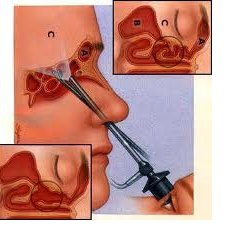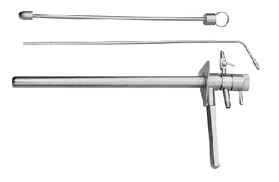
Nasal endoscopy is a vital diagnostic and therapeutic procedure used by ENT specialists to visualize the internal structures of the nasal cavity and sinuses with high precision. It involves the use of a thin, flexible or rigid fiberoptic scope inserted through the nostrils, providing magnified real-time images of nasal passages, sinus openings, and the nasopharynx.
This minimally invasive technique revolutionizes the evaluation and management of various nasal and sinus disorders by allowing direct inspection, targeted biopsies, removal of polyps, and guidance for surgeries such as Functional Endoscopic Sinus Surgery (FESS).

Nasal endoscopy has become an indispensable tool for diagnosing chronic nasal obstruction, sinusitis, nasal polyps, tumors, and epistaxis (nosebleeds), among other conditions. This article presents a detailed overview of nasal endoscopy, including causes and risk factors for undergoing the procedure, symptoms indicating its necessity, diagnostic significance, treatment options it facilitates, prevention and management post-procedure, possible complications, and patient experiences.
Indications for Nasal Endoscopy
-
Chronic Rhinosinusitis: Persistent inflammation or infection lasting beyond 12 weeks.
-
Nasal Obstruction: Caused by deviated nasal septum, hypertrophied turbinates, or polyps.
-
Nasal Polyps: Benign growths causing blockage and breathing difficulty.
-
Epistaxis: Recurrent or severe nosebleeds requiring source identification.
-
Sinonasal Tumors: Suspected masses requiring visualization and biopsy.
-
Chronic Nasal Discharge or Postnasal Drip: Unexplained or resistant to medical treatment.
-
Head and Neck Cancer Follow-up: Surveillance after treatment.
-
Foreign Bodies: Detection and removal of nasal foreign objects.
Risk Factors Leading to Conditions Requiring Nasal Endoscopy
-
Allergic rhinitis or other allergic conditions.
-
Recurrent upper respiratory infections.
-
Environmental exposure to pollutants or irritants.
-
Smoking and tobacco use.
-
Anatomical abnormalities, including septal deviation.
-
Immune deficiency or systemic diseases affecting mucosal immunity.
Patients who are candidates for nasal endoscopy often present with the following clinical features:
-
Persistent Nasal Congestion or Blockage: Not responding to medical therapy.
-
Chronic Nasal Discharge: Especially if purulent or bloody.
-
Facial Pain or Pressure: Suggestive of sinus involvement.
-
Recurrent Nosebleeds: Particularly from one nostril.
-
Loss or Alteration of Sense of Smell: Hyposmia or anosmia.
-
Postnasal Drip and Chronic Cough: Due to drainage irritation.
-
Snoring or Sleep Disturbance: Possibly related to nasal obstruction.
-
Visible Nasal Mass or Deformity: Noted on examination.
Procedure Overview
-
Typically performed in an outpatient setting.
-
Local anesthesia and decongestant sprays applied to minimize discomfort.
-
A flexible or rigid endoscope (2.7-4 mm diameter) is gently introduced into the nasal cavity.
-
Detailed examination of the nasal septum, turbinates, meatuses, sinuses’ natural openings, nasopharynx, and Eustachian tube orifices.
Diagnostic Utility
-
Direct visualization allows identification of mucosal swelling, polyps, purulent secretions, anatomical variants, and tumors.
-
Facilitates targeted biopsy of suspicious lesions.
-
Guides therapeutic interventions such as debridement or removal of foreign bodies.
-
Helps assess the success of prior surgeries or medical treatments.
-
Guided Polypectomy: Removal of nasal polyps under endoscopic visualization.
-
Sinus Drainage and Debridement: Clearing infected material to relieve symptoms.
-
Biopsy and Resection of Tumors: Minimally invasive tissue sampling or excision.
-
Epistaxis Management: Identification and cauterization of bleeding vessels.
-
Foreign Body Removal: Safe extraction under direct vision.
-
Preoperative Evaluation: Crucial in planning surgeries like septoplasty or FESS.
Preventive Strategies
-
Effective treatment of allergies and upper respiratory infections.
-
Avoidance of environmental irritants and tobacco smoke.
-
Proper nasal hygiene including saline nasal irrigation.
Post-Endoscopy Management
-
Patients may experience mild nasal irritation or bleeding; advised to avoid nose blowing and strenuous activity briefly.
-
Continued use of prescribed nasal sprays or medications.
-
Follow-up endoscopy may be necessary for chronic or recurrent conditions.
-
Early reporting of complications like persistent bleeding or infection.
Nasal endoscopy is generally safe but may have minor risks:
-
Nasal Discomfort or Pain: Usually transient.
-
Minor Bleeding: Due to mucosal irritation or trauma.
-
Vasovagal Reactions: Lightheadedness or fainting.
-
Allergic Reaction: To local anesthetics or decongestants.
-
Rarely, Infection: If sterile technique is compromised.
-
Damage to Nasal Structures: Extremely rare with experienced operators.
-
Nasal endoscopy is typically well tolerated and often leads to significant symptom improvement when combined with appropriate treatment.
-
Many patients report enhanced quality of life after targeted therapies guided by endoscopic diagnosis.
-
Adherence to preventive care, such as allergy management and nasal hygiene, reduces recurrence risk.
-
Patients with chronic sinus or nasal disorders benefit from periodic endoscopic evaluation for early intervention.
-
Education about symptom recognition and timely follow-up improves long-term outcomes.
1. What is nasal endoscopy?
Nasal endoscopy is a diagnostic procedure that uses a thin, flexible or rigid tube called an endoscope, equipped with a light and camera, to visualize the inside of the nasal passages and sinuses.
2. Why is nasal endoscopy performed?
It is performed to diagnose and evaluate nasal and sinus problems such as chronic sinusitis, nasal polyps, tumors, bleeding, infections, or structural abnormalities.
3. How is nasal endoscopy performed?
The procedure involves inserting the endoscope gently into the nostrils after applying a local anesthetic spray to minimize discomfort. The doctor then examines the nasal cavity and sinuses via a video monitor.
4. Is nasal endoscopy painful?
Nasal endoscopy is generally well tolerated and causes minimal discomfort. The local anesthetic spray helps reduce any irritation or sneezing during the procedure.
5. How long does the procedure take?
The entire procedure usually takes about 5 to 15 minutes, depending on the extent of examination and any interventions performed.
6. Are there any risks or complications?
Nasal endoscopy is a safe procedure with minimal risks. Possible minor complications include nasal irritation, bleeding, or sneezing. Serious complications are very rare.
7. How should I prepare for nasal endoscopy?
No special preparation is typically needed. Inform your doctor about any allergies, medications, or nasal conditions you have.
8. What can nasal endoscopy detect?
It can detect inflammation, polyps, tumors, foreign bodies, infections, structural issues like a deviated septum, and sources of nasal bleeding.
9. Will I need any follow-up after nasal endoscopy?
Follow-up depends on the findings. Your doctor may recommend medical treatment, further tests, or surgery based on the results.
10. Can nasal endoscopy be used for treatment?
Yes, in addition to diagnosis, nasal endoscopy can assist in minimally invasive surgical procedures, such as removing polyps or biopsies.
SurgeryPlanet is an Healthcare Facilitator and not a Medical service provider. The information provided in this website is not to be used for diagnosis or treatment of any medical condition or use for any medical purposes. We provide information solely for medical travel facilitation and do not endorse any particular health care provider, hospital, facility, destination or any healthcare service or treatment listed. We are not an agent for, or affiliated to any health care provider, or service listed in our website and is not responsible for health care services provided by them. Choice of hospital or doctor for your healthcare services is your independent decision. Consult your domestic licensed health care provider before seeking the services of any health care provider you learn about from our website.

